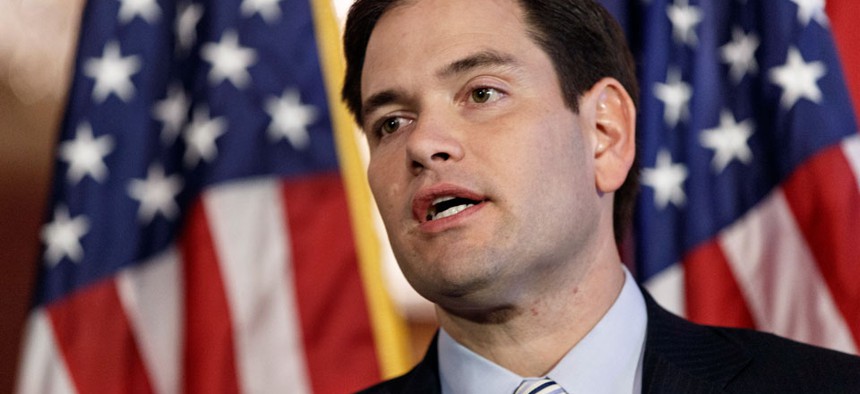
Sen. Marco Rubio, R-Fla. J. Scott Applewhite/AP
Lawmakers Clash With Senior Execs Over Power to Fire at Veterans Affairs
New legislation would give department secretary more authority to sack top career employees for alleged mismanagement.
The Veterans Affairs secretary would have more authority to fire or demote poor-performing career executives under legislation introduced Tuesday in both chambers, prompting a rebuke from the Senior Executives Association.
“This legislation would give VA leaders a tool to address a problem that continues to get worse by the day,” said Rep. Jeff Miller, R-Fla., who is chairman of the House Veterans’ Affairs Committee, and the bill’s sponsor. “VA’s widespread and systemic lack of accountability is exacerbating all of its most pressing problems, including the department’s stubborn disability benefits backlog and a mounting toll of at least 31 recent preventable veteran deaths at VA medical centers across the country,” he said.
In unveiling the 2014 VA Management Accountability Act, Miller acknowledged “the vast majority” of VA’s more than 300,000 employees as dedicated and hard-working. But he has long pressured the department to remove or deny bonuses to allegedly neglectful executives he views as responsible for veterans’ deaths from such causes as Legionnaires’ disease, as documented in reports from the department’s inspector general and the Government Accountability Office.
Sen. Marco Rubio, R-Fla., offered a companion bill also on Tuesday. “Current law ostensibly allows SES workers, a group representing the bulk of VA’s senior leaders, to be disciplined and fired, but there are considerable amounts of red tape involved and the process can drag on for long periods of time,” Rubio said. “This bill gets rid of these hurdles in order to give the VA secretary authorities similar to those members of Congress have to fire employees from their staffs.”
In fiscal 2012, there were 448 career SES employees at VA, Miller said.
SEA President Carol A. Bonosaro immediately issued a statement opposing the bill. “Not only is this bill a solution in search of a problem, it is unfair and does not further the goal that we all share to ensure the highest quality care for our nation’s veterans,” she said. “Nearly one-third of the career members of the Senior Executive Service working at the VA are themselves veterans. They share a commitment to continued public service, and it is a shame that the very committee that is looking for ways to increase the presence of veterans in the federal workforce would now enable firing those at the highest career levels without any due process whatsoever.”
Bonosaro linked the Miller-Rubio proposal to recent rhetoric surrounding federal employees that “is largely driven by optics rather than the policy needs of the government and the American people.” She said agencies already have the means to remove bad employees that is “nonpartisan, free from political influence and free from the corruption that plagues many other nations.”
SEA also challenged Miller’s assertion that a GAO report concluded that SEA pay was not linked to performance, saying senior executives actually are more vulnerable to removal than other employees. “Federal employees are routinely fired, and red tape is not the problem,” Bonosaro added.
After Miller raised concerns about VA executive performance last year, Veterans Affairs Secretary Eric Shinseki wrote the lawmaker on Jan. 31 to say he believes the department already has authority to fire poor performers. “One of the goals of the SES is to ensure accountability for efficient and effective government,” he wrote. “This is achieved by holding senior executives accountable for their individual and organizational performance through a rigorous performance appraisal program.”
NEXT STORY: How I Lead: By Not Trying Too Hard To Be Liked







